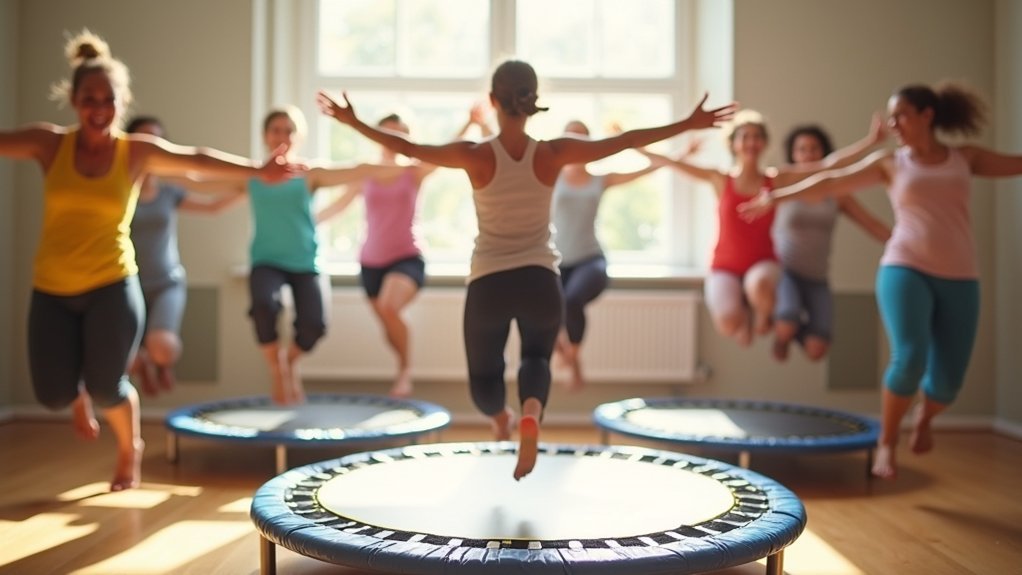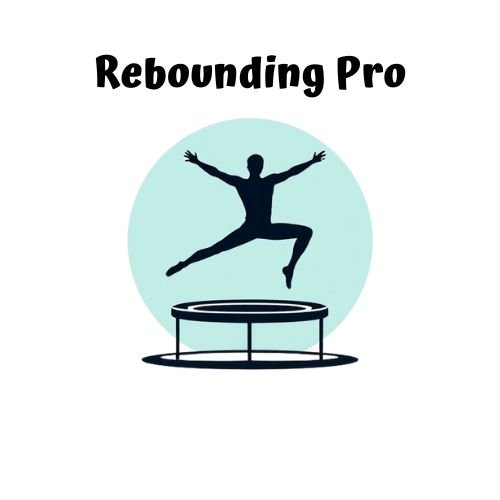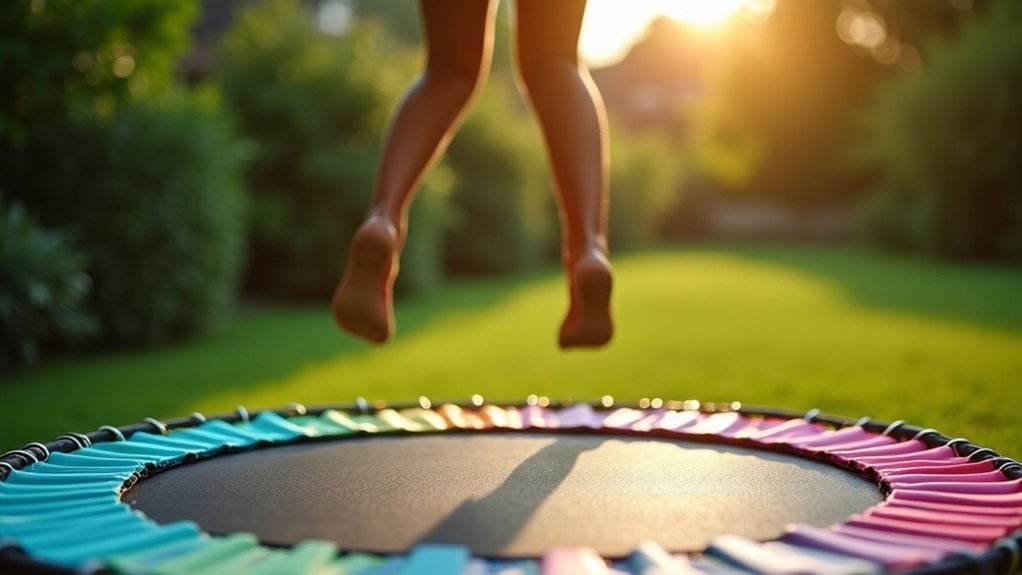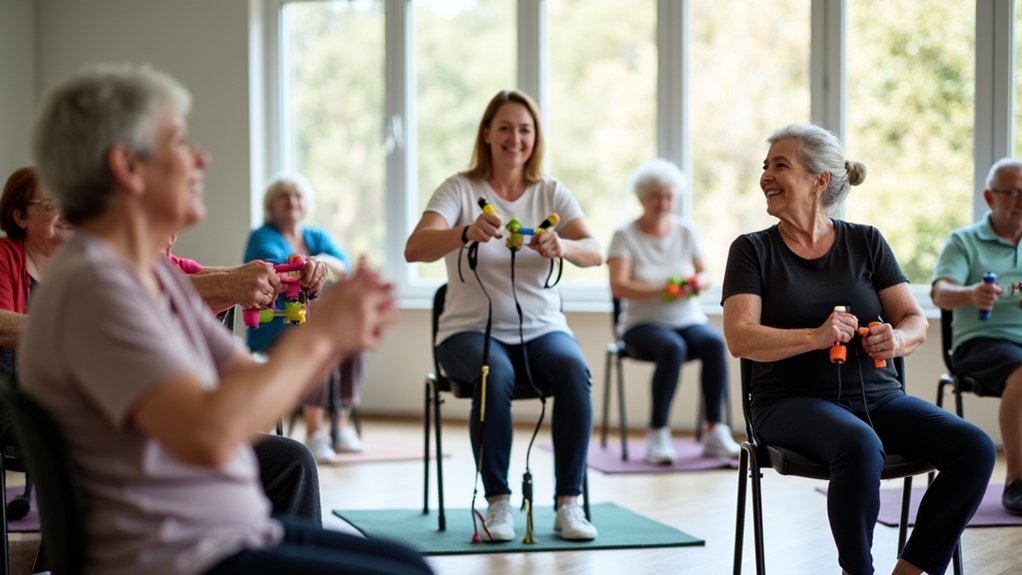Mini-trampolines transform your balance by simultaneously engaging your vestibular system and cerebellum with each bounce. The unstable surface forces your body to continuously make micro-adjustments, strengthening core stability and proprioception. Just 10 minutes daily activates the sensory receptors in your muscles and joints, creating stronger neural connections for improved spatial awareness and coordination. These balance improvements translate directly to everyday movements and greatly reduce your fall risk as you age. Let’s explore how to maximize these benefits.
The Science Behind Trampoline Balance Training

While many view mini-trampolines as purely recreational devices, they actually serve as powerful tools for improving balance through sophisticated neurological mechanisms.
When you bounce, your vestibular system—responsible for spatial orientation—receives continuous stimulation, forcing your brain to adapt and improve balance responses.
Your cerebellum becomes highly engaged during mini trampoline exercises, enhancing motor control and coordination with each bounce.
The cerebellum’s constant activation during rebounding creates a neural training ground, fine-tuning your coordination with every jump.
The science is compelling: the unique bungee suspension absorbs over 80% of impact while simultaneously challenging your proprioception—your body’s awareness of position in space.
Just 10 minutes daily on a mini trampoline can greatly improve your balance capabilities.
This occurs because your body constantly makes micro-adjustments during rebounds, training your neuromuscular system to maintain stability more effectively in everyday movements.
How Mini-Trampolines Engage Your Vestibular System
As you bounce on a mini-trampoline, your vestibular system springs into action, processing a complex array of sensory information with each rebound. This inner ear mechanism is your body’s balance command center, and mini trampolines provide the perfect stimulus to strengthen it.
The rhythmic up-and-down movement creates dynamic challenges that your vestibular system must continuously adapt to, enhancing your spatial orientation and balance capabilities.
- Each bounce stimulates inner ear structures, improving your brain’s balance processing
- The unpredictable nature of rebounds enhances proprioception—your body’s position awareness
- Regular jumping strengthens vestibular-cerebellar connections, reducing fall risk
- The varying intensities of bouncing create natural balance training scenarios
You’re not just having fun—you’re actively rewiring your brain’s balance networks with every jump.
Core Stabilization Through Rebounding Exercises

Beneath the exhilarating bounce of mini-trampoline workouts lies a powerful core-strengthening mechanism that transforms your stability from the inside out.
When you’re rebounding, your body constantly adjusts to the unstable surface, forcing your core muscles to engage intensively to maintain balance during each dynamic movement.
Research shows that just 10 minutes daily on a mini-trampoline considerably activates your pelvic floor and core muscles, enhancing your stability during all physical activities.
This core stabilization benefit extends beyond strength—it improves your proprioception and coordination as your body learns to respond efficiently to shifting surfaces.
You’ll find that regular rebounding exercises develop reflexes essential for preventing falls while improving your everyday mobility.
Your core becomes both stronger and smarter, creating a foundation for better balance throughout life.
Proprioceptive Benefits of Unstable Surfaces
The moment you step onto a mini-trampoline, your body’s proprioceptive system springs into action, creating a neural cascade that sharpens your spatial awareness. This unstable surface challenges your body in ways traditional workouts can’t match, forcing continuous postural adjustments that strengthen your balance control mechanisms.
- Your muscles and joints contain sensory receptors that become highly activated during mini-trampoline exercises.
- Each bounce triggers proprioceptive feedback that improves your body’s positional awareness.
- Your brain forms stronger neural connections related to balance with regular practice.
- You’ll experience enhanced coordination that translates to everyday movements and reduced fall risk.
Research confirms that these proprioceptive benefits are especially valuable as you age, making mini-trampolines an effective tool for maintaining independence and preventing injuries through improved balance.
HIIT Rebounding Sequences for Progressive Balance Improvement

High-intensity interval training (HIIT) on mini-trampolines takes those proprioceptive benefits to the next level, creating a potent formula for accelerated balance improvement. Just 10 minutes of trampoline HIIT can greatly enhance your stability and coordination through dynamic lower body engagement.
| Exercise | Intensity | Balance Benefit |
|---|---|---|
| Side Hops | High intensity | Lateral stability |
| High Knees | Maximum effort | Core control |
| Tuck Jumps | Very high | Proprioception |
| Heel Taps | Moderate high | Ankle strength |
| Twists | High intensity | Rotational control |
For best results, you’ll want to perform these sequences three times weekly. The engaging nature of trampoline workouts guarantees you’ll stick with your balance training regimen. As you progress, you’ll notice improved control during directional changes and everyday movements.
Adapting Trampoline Workouts for Different Fitness Levels
Regardless of your current fitness level, mini-trampoline workouts can be customized to challenge your balance capabilities appropriately while ensuring both safety and effectiveness.
Even older people can benefit from tailored rebounding exercises that progressively build stability and confidence.
- Beginners: Start with simple side-to-side hops while holding a handrail, gradually building confidence with 5-10 minute sessions, three days weekly.
- Intermediate: Incorporate dynamic movements like high knees and twists to engage larger muscle groups without joint strain.
- Advanced: Challenge yourself with complex routines or added weights for maximum cardiovascular benefits.
- Group Settings: Join classes where a personal trainer can adjust difficulty levels, allowing you to progress at your own pace while enjoying social interaction.
Measurable Balance Gains From Regular Rebounding
Five concrete benefits emerge when examining the measurable balance improvements from regular mini-trampoline workouts. You’ll experience enhanced dynamic balance with just 5-10 minutes of rebounding three times weekly. The trampoline’s bungee suspension system strengthens your stabilizing muscles while remaining low-impact.
| Time Frame | Balance Improvement | Supporting Mechanism |
|---|---|---|
| 2-4 weeks | Enhanced stability | Proprioceptive awareness |
| 1 month | Better coordination | Strengthened ankles/calves |
| 6 weeks | Improved reflexes | Neural adaptation |
| 3 months | Core stabilization | Activated pelvic floor muscles |
Your body’s proprioceptive awareness increases considerably during trampoline workouts, making you more conscious of your positioning in space. This heightened awareness translates directly to measurable balance gains in everyday activities, particularly beneficial as you age.
Preventing Falls Through Trampoline Training
Falls represent one of the most significant health risks for older adults, but mini-trampoline training offers a practical solution to this pervasive problem.
Falls threaten seniors’ well-being, yet the humble mini-trampoline provides an accessible defense against this common danger.
You’ll strengthen your lower body muscles and improve stability with just 5-10 minutes of rebounding three times weekly. The trampoline’s bungee system absorbs 80% of impact, protecting your joints while you work on balance.
- Engages your vestibular system and enhances proprioception—crucial components for preventing falls
- Improves pelvic floor function, reducing urinary incontinence that can contribute to falls
- Builds confidence maneuvering uneven or slippery surfaces in daily life
- Develops coordination and reflexes that help you catch yourself before falling
This combination of physical strength and neurological training creates thorough protection against one of aging’s most dangerous challenges.
Mini-Trampoline Exercises That Challenge Equilibrium
You’ll push your balance limits with dynamic stabilization drills like side-to-side hops and twisting exercises that challenge your core and refine coordination.
Single-leg balance progressions, starting with basic stands and advancing to bounce-down movements, train your body to maintain equilibrium during unstable conditions.
These exercises strengthen stabilizing muscles throughout your body while improving your spatial awareness, making everyday movements more controlled and deliberate.
Dynamic Stabilization Drills
The unstable surface of a mini-trampoline creates an ideal environment for developing balance and coordination through dynamic stabilization exercises. Your body must constantly adjust to maintain equilibrium, enhancing your proprioception—the internal awareness of your body’s position in space.
- Perform high knees while maintaining your center of gravity to challenge your balance reflexes.
- Add twisting movements to engage multiple muscle groups simultaneously.
- Incorporate elastic resistance bands to target specific stability muscles.
- Practice single-leg exercises to improve unilateral balance control.
These dynamic stabilization drills don’t just improve your balance on the trampoline—they translate to better stability in everyday movements.
Research shows consistent practice markedly reduces fall risk, especially for older adults, by training your body’s natural balance systems through continuous adaptation.
Single-Leg Balance Progressions
Mastering single-leg balance on a mini-trampoline represents one of the most effective ways to challenge your equilibrium and enhance stability.
The trampoline’s elastic surface creates a dynamic environment that forces your body to constantly adjust, engaging core strength and improving proprioception.
Try starting with basic single-leg stands, then progress to more challenging variations like reaching movements or gentle twists while maintaining your balance.
Single-leg hops followed by holds will further test your coordination and stability.
Just 10 minutes of daily practice can yield considerable improvements in your overall balance.
This time-efficient exercise is particularly beneficial for older adults or those with joint concerns, as it notably reduces fall risk while strengthening stabilizing muscles throughout your body.
Combining Strength and Balance Work on Rebounders
While many fitness enthusiasts view mini-trampolines primarily as cardio equipment, these versatile devices offer an exceptional platform for simultaneously developing strength and balance.
The bungee suspension system creates a low-impact environment where you can challenge your proprioception while building muscle.
When you perform exercises on a rebounder, you’re constantly engaging stabilizing muscles to maintain balance, effectively doubling your workout’s benefits.
- Side-to-side hops strengthen your legs while forcing your core to stabilize
- The unstable surface enhances proprioception, improving your body’s spatial awareness
- Strength exercises become more challenging as your muscles work to maintain balance
- Regular practice promotes neuroplasticity, benefiting both physical strength and cognitive function
The Neurological Impact of Rhythmic Bouncing
When you bounce rhythmically on a mini-trampoline, you’re actively engaging your cerebellum, the brain’s movement control center that coordinates balance and spatial awareness.
Your vestibular system, located in the inner ear, undergoes essential recalibration with each bounce, helping your brain better interpret your body’s position in space.
These neurological adaptations work together to enhance your proprioception and balance capabilities, creating lasting improvements that extend beyond your trampoline sessions.
Cerebellum Activation Mechanisms
As you bounce rhythmically on a mini-trampoline, your cerebellum—the brain’s coordination center—springs into action, processing a complex array of sensory information. This activation creates a neurological symphony that enhances your balance through repeated stimulation of neural pathways.
Your cerebellum receives and integrates:
- Vestibular signals that track your head position as you bounce up and down
- Visual inputs that help maintain spatial awareness during each rebound
- Proprioceptive feedback from muscles and joints responding to the trampoline’s unique bungee suspension
- Motor commands that continuously adjust your posture for stability
This cerebellum activation doesn’t just improve your physical balance—it strengthens cognitive functions too.
With regular bouncing, you’re training your brain to better coordinate movements, multitask, and respond quickly to changing environments both on and off the trampoline.
Vestibular System Recalibration
The rhythmic bouncing of mini-trampoline exercise triggers a profound recalibration of your vestibular system—the intricate network of fluid-filled canals in your inner ear. This gentle yet consistent stimulation sends rapid signals to your brain, enhancing its ability to process spatial orientation and movement with greater precision.
As you bounce, you’re actively training your proprioception—your body’s awareness of its position in space. Your brain continuously recalibrates this internal positioning system, improving coordination and stability with each session.
The multi-sensory input combines vestibular feedback with proprioceptive signals, creating a neurological training ground for balance enhancement. This vestibular recalibration process is particularly valuable as you age, when balance naturally deteriorates.
Regular trampoline sessions strengthen these neural pathways, resulting in measurable improvements to your balance and spatial awareness.
Tracking Your Balance Progress With Simple Assessments
Five straightforward assessment methods can help you monitor your balance improvements while using a mini-trampoline.
Standing on one leg for as long as possible provides a simple benchmark that you’ll see improve over time. Meanwhile, tracking how steadily you perform side-to-side hops on your trampoline reveals coordination gains as wobbling decreases.
Keep a journal of your mini-trampoline workouts to visualize progress and maintain motivation.
Tracking your mini-trampoline sessions creates a visual record of achievements that fuels continued commitment to your balance journey.
You’ll notice significant improvement in:
- Your ability to shift between movements (bouncing to twisting)
- Duration you can perform exercises before fatigue
- Control during dynamic movements
- Time required to complete specific exercise sequences
Timed tests are particularly valuable assessments, offering concrete data that demonstrates your balance progress through measurable improvements in both stability and endurance.
Real-World Balance Applications From Trampoline Training
Your daily trampoline practice builds stability that extends far beyond the bouncing surface, helping you navigate crowded sidewalks or stand steady on moving buses with newfound confidence.
The balance skills you’re developing translate directly to fall prevention, especially valuable as you age or when walking on uneven terrain or slippery surfaces.
The rhythmic bouncing movements train your body to make micro-adjustments that improve functional movements in everyday tasks, from reaching for items on high shelves to quickly changing direction while walking.
Stability in Daily Life
When you step off your mini-trampoline, the balance benefits don’t stay behind—they follow you into every aspect of daily life. The improved stability and coordination you’ve developed translate directly to real-world scenarios, helping you confidently navigate challenging environments.
Your enhanced proprioception and stimulated cerebellum work together to keep you steady whether you’re walking on uneven sidewalks or rushing through crowded spaces.
- Climb stairs and traverse uneven surfaces with greater confidence and reduced fall risk
- Handle slippery conditions more effectively thanks to improved reflexes and coordination
- Move in and out of vehicles and public transportation with enhanced stability
- Maintain independence in daily activities through better balance management
These practical applications make mini-trampoline training far more than just exercise—it’s preparation for life.
Fall Prevention Benefits
Although most people initially purchase mini-trampolines for fitness reasons, their most significant impact might be in preventing falls—particularly for older adults. The balance improvements from regular rebounding directly correlate with lower fall rates, making these devices powerful tools for maintaining independence.
Just 5-10 minutes of trampoline exercises three times weekly can dramatically boost your dynamic balance, enhancing your ability to navigate challenging environments safely.
The mini-trampoline’s bungee suspension system absorbs over 80% of impact, offering joint-friendly training while strengthening essential muscles in your feet, ankles, and calves.
Beyond physical strength, your enhanced proprioception and reflexes from consistent practice translate to real-world fall prevention benefits—whether you’re boarding public transportation or walking on slippery surfaces.
You’ll move with greater confidence and stability in daily activities.
Functional Movement Transfer
Mini-trampoline exercises don’t just improve your balance within the bouncing session—they fundamentally transform how you move throughout your daily life.
The proprioception and stability skills you develop while bouncing directly enhance your functional movement in everyday scenarios.
The neuromuscular coordination gained through trampoline training helps your body respond more effectively when traversing uneven surfaces or making sudden directional changes.
Your improved dynamic balance transfers seamlessly to daily activities, reducing fall risk and increasing confidence.
- Enhanced proprioception for more stable walking and standing
- Stronger core engagement that supports overall body stability
- Better response to unexpected balance challenges in real-world situations
- Improved joint protection through the low-impact nature of trampoline movement
This functional transfer is what makes mini-trampoline training uniquely effective for developing real-world balance skills that last.
Creating a Sustainable HIIT Rebounding Routine for Lifelong Balance
Creating a sustainable HIIT rebounding routine doesn’t require hours of your time, but rather strategic planning for maximum benefits. Just 10 minutes daily can greatly enhance your balance, coordination, and stability while reducing fall risk.
Structure your routine with 30-second high-intensity jumps followed by 30-second rest periods, incorporating side-to-side hops, high knees, and twists to target multiple muscle groups. This approach improves proprioception and reflexes—critical for maintaining lifelong balance.
| Exercise Type | Balance Benefit | Emotional Reward |
|---|---|---|
| Side-to-Side Hops | Lateral Stability | Confidence |
| High Knees | Core Strength | Energy |
| Twists | Rotational Control | Freedom |
| Bounce & Hold | Proprioception | Stability |
| Alternating Jumps | Coordination | Joy |
Add music to boost motivation and make your rebounding practice enjoyable for long-term adherence.
Frequently Asked Questions
Is a Mini-Trampoline Good for Balance?
Yes, a mini-trampoline greatly improves your balance. You’ll strengthen vital muscles in your feet, ankles, and calves while enhancing proprioception and reflexes. Even 5-10 minutes three times weekly can transform your stability.
What Is 10 Minutes on a Rebounder Equivalent To?
Ten minutes on a rebounder equals a longer running session for cardiovascular benefits. You’ll get comparable oxygen use, muscle engagement, and endorphin release while enjoying 80% less joint impact than traditional exercises.
How to Improve Balance in Trampolining?
To improve balance while trampolining, practice single-leg stands, heel-to-toe walking on the surface, incorporate side-to-side movements, and do gentle twists. You’ll strengthen your core and enhance your proprioceptive awareness with consistent practice.
Will Trampoline Tone My Body?
Yes, trampolining will tone your body. You’ll engage major muscle groups, burn calories, and build strength throughout your body. Regular sessions can effectively tone your legs, core, and arms while being low-impact.
In Summary
You’ve discovered mini-trampolines aren’t just fun—they’re balance transformation tools. By challenging your vestibular system, strengthening your core, and enhancing proprioception, you’re building practical stability for everyday life. With consistent rebounding practice, you’ll notice improved coordination, better posture, and increased confidence in movement. Start small, track your progress, and you’ll enjoy the balance benefits long after you’ve stepped off the trampoline.





Leave a Reply